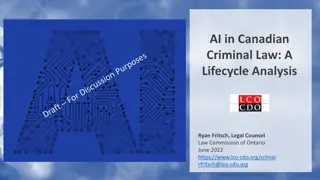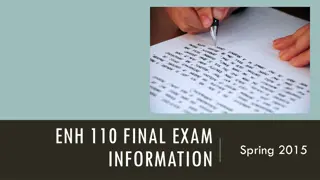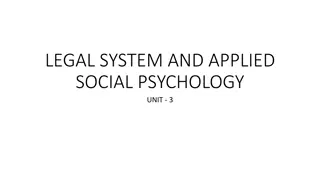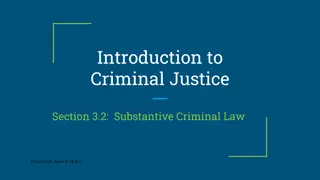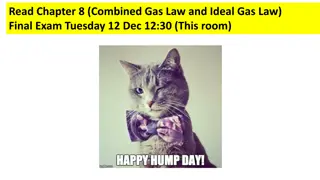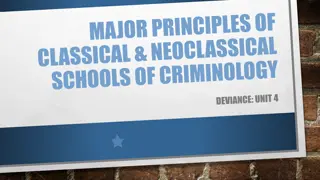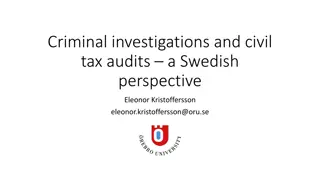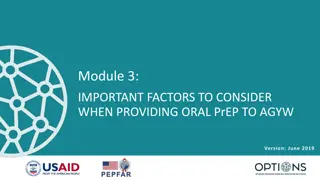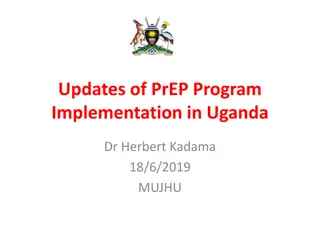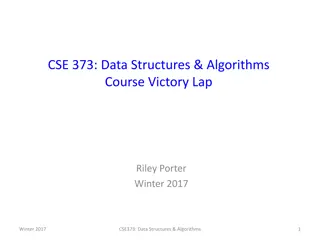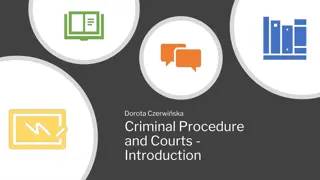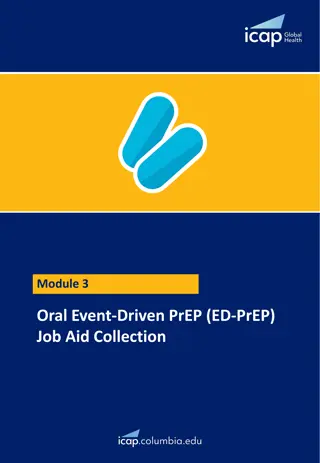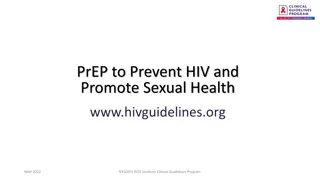Understanding Criminal Law: Final Exam Prep Tips
Explore the format of the CRW1501 final examination, learn how to tackle question 1 effectively, and get insights into criminal law concepts. Familiarize yourself with sources of law, legislation, and key aspects to excel in your studies. Enhance your understanding of criminal law through practical examples and guidance on answering exam questions accurately.
Download Presentation

Please find below an Image/Link to download the presentation.
The content on the website is provided AS IS for your information and personal use only. It may not be sold, licensed, or shared on other websites without obtaining consent from the author. Download presentation by click this link. If you encounter any issues during the download, it is possible that the publisher has removed the file from their server.
E N D
Presentation Transcript
INTRODUCTION TO CRIMINAL INTRODUCTION TO CRIMINAL LAW LAW CRW1501
CONTACT LECTURE CONTACT LECTURE (Semester 2/2018)
THE FORMAT OF THE CRW1501 FINAL EXAMINATION QUESTION PAPER 4 COMPULSORY QUESTIONS. TOTAL: 100 MARKS. SUB-MINIMUM REQUIRED: 40% QUESTION 1: questions similar to assignment 01. True/False (10) QUESTION 2: questions based on legality, the act/conduct, causation(30) QUESTION 3: questions based on unlawfulness/ grounds of justification(30) QUESTION 4: questions based on culpability(30)
HOW TO ANSWER QUESTION 1 IN FINAL EXAM HOW TO ANSWER QUESTION 1 IN FINAL EXAM Five questions, marked 1 to 5, follow. Each question contains three statements marked (a) to (c). Some of the statements are correct, while others are incorrect. You must decide which of the statements is/are correct. The three statements are followed by five allegations. Each of them alleges that a certain statement or combination of statements is correct. You must decide which allegation accurately reflects the conclusion you have reached and write down only the corresponding number in your exam answer book(either 1, 2, 3, 4 or 5).
Carefully read the three statements marked (a) to (c) below: (a) As far as legislation as a source of law is concerned, the most important source is the rules of common law. (b) As far as legislation as a source of law is concerned, the most important of all the Acts is the Constitution of the Republic of South Africa, 1996. (This statement is correct.) (c) As far as legislation as a source of law is concerned, the most important source is the writings of the Roman-Dutch authors. Decide which of the above statements is/are correct.
(1) Only statement (a) is correct. (2) Only statement (b) is correct. (This allegation is correct, since it reflects that only statement b is correct.) (3) Only statements (a) and (b) are correct. (4) Only statement (c) is correct. (5) Only statements (b) and (c) are correct.
Which of the five allegations above reflect your choice? In the above example it should be 2, since that would mean that statement (b) is the correct one. Now simply write down 2 in your exam answer book. NB NB: you do NOT answer Question 1 on a separate mark reading sheet- no matter what the invigilator says!!!
LEGALITY LEGALITY BEFORE X CAN BE CHARGED WITH A CRIME IT MUST BE DETERMINED THAT THE CONDUCT WHICH WILL FORM THE BASIS OF THE CHARGE IS IN FACT RECOGNISED AS A CRIME IN OUR COMMON LAW OR STATUTORY LAW. THIS IS THE ESSENCE OF THE PRINCIPLE OF LEGALITY. THERE CAN BE NO CRIME WITHOUT LAW. YOU MUST KNOW: WHAT THE PRINCIPLE MEANS + THE RULES CONTAINED IN THE PRINCIPLE!
LEGALITY (continued) A court can only convict and punish an accused for a crime if the conduct is recognised by the law (statutory or common law) as a crime. Courts, in other words, can not create new crimes. The conduct must also have some penalty attached to its commission. The conduct of the accused person must have been recognised as a crime at the time of its commission. This rule is referred to as the prohibition on retrospectivity and is confirmed as part of South African law by virtue of its inclusion in the South African Constitution.
LEGALITY (continued) LEGALITY (continued) Crimes have to be defined in clear and precise language. In other words crimes can not be defined vaguely. A court of law must interpret the wording in the definition of a crime strictly or narrowly. This rule applies to both common law and statutory crimes. Once an accused person has been found guilty, the above four rules also have to apply to sentencing.
LEGALITY (continued) LEGALITY (continued) Q: DOES THE FOLLOWING CHARGE MEET THE REQUIREMENTS OF THE PRINCIPLE OF LEGALITY? EXPLAIN. PARLIAMENT ENACTS A NEW LAW PROVIDING THAT IT IS A CRIME IF A PERSON DOES NOT BEHAVE PROPERLY IN PUBLIC. [2]
LEGALITY (continued) No, this law does not meet the requirements of the principle of legality. Not behaving properly in public is vague and uncertain. There is also no penalty attached to this law.
THE FOUR ELEMENTS OF A THE FOUR ELEMENTS OF A CRIME CRIME ACT/CONDUCT COMPLIANCE WITH DEFINITIONAL ELEMENTS UNLAWFULNESS CULPABILITY
ACT/CONDUCT Voluntary, human act or omission to act Omission more the exception: not acting in situations where a legal duty to act existed An act is voluntary if X can subject his bodily movements to his will or intellect Cannot be the act/conduct of an animal Factors which exclude voluntary nature of act: absolute force; natural force; automatism (blackout, sleepwalking, dreaming).
COMPLIANCE WITH DEFINITIONAL COMPLIANCE WITH DEFINITIONAL ELEMENTS ELEMENTS Definitional elements of a crime: the concise definition of the conduct required for a crime and the circumstances in which it took place Murder is the unlawful and intentional causing of death of another human being Robbery requires the unlawful and intentional violent taking of movable corporeal property belonging to another person
CAUSATION Find a causal link between X s act and the result. Factual causation (condition sine qua non or but for causation). In other words, without X s conduct, the prohibited result would not have occurred. Or butfor X s conduct the prohibited result would not have occurred
CAUSATION (continued) Q: X shoots Y and Y dies. Is X the factual cause of Y s death? IN ORDER TO BE THE FACTUAL CAUSE OF Y S DEATH, X S CONDUCT MUST BE A CONDITIO SINE QUA NON OF Y S DEATH. IN OTHER WORDS, BUT FOR X S CONDUCT, Y WOULD NOT HAVE DIED. IN THIS EXAMPLE, IF IT WERE NOT FOR X SHOOTING Y, Y WOULD NOT HAVE DIED. X IS THEREFORE THE FACTUAL CAUSE OF Y S DEATH.
CAUSATION (continued) CAUSATION (continued) Legal causation Legal causation Different theories used to prove legal causation Individualisation Theory: look for the most operative factual cause of Y s death and single out this cause. Adequate Causation Theory: look at the cause which according to normal, human experience has a tendency to bring about a certain result. Novus Actus Interveniens Theory: means a new intervening event which breaks the chain of causation (between X s act and the eventual result- new intervening cause of death).
CAUSATION (continued) Q: X wants to kill Y. X pulls out a gun and shoots Y. However, the bullet only grazes Y s skin. Y flees into a nearby abandoned house. However the ceiling in the house collapses and Y is killed. Is X the legal cause of Y s death?
CAUSATION (continued) IN ORDER TO PROVE LEGAL CAUSATION WE USE DIFFERENT THEORIES AND POLICY CONSIDERATIONS. IN TERMS OF THE INDIVIDUALISATION THEORY, WE SINGLE OUT THE MOST OPERATIVE FACTUAL CAUSE OF Y S DEATH. IN THIS EXAMPLE, THE MOST OPERATIVE FACTUAL CAUSE WOULD BE THE CEILING IN THE HOUSE WHICH COLLAPSED AND WHICH KILLED Y. IN TERMS OF THE ADEQUATE CAUSE THEORY, WE LOOK AT THE CAUSE, WHICH ACCORDING TO NORMAL HUMAN EXPERIENCE WOULD BRING ABOUT THE DEATH. SINCE X SHOT Y WITH A GUN, AN ORDINARY HUMAN WOULD EXPECT Y TO HAVE BEEN KILLED. THEREFORE THE SHOOTING BY X WOULD BE THE ADEQUATE CAUSE OF Y S DEATH.
CAUSATION (continued) IN TERMS OF THE THEORY OF NOVUS ACTUS INTERVENIENS , WHICH MEANS A NEW INTERVENING EVENT/ OR CAUSE BETWEEN X S INITIAL ACT AND THE EVENTUAL RESULT (THE DEATH OF Y) BREAKS THE CHAIN OF CAUSATION AND CAUSES THE DEATH. IN THIS EXAMPLE, THE INITIAL EVENT WAS THE SHOOTING BY X. THE NEW INTERVENING EVENT WAS THE CEILING WHICH COLLAPSED AND WHICH KILLED Y. THEREFORE IT CAN BE SAID THAT THIS NOVUS ACTUS INTERVENIENS (THE CEILING WHICH COLLAPSED) WAS THE LEGAL CAUSE OF Y S DEATH. IN PRACTICE, THE THEORY WHICH IS MOST REASONABLE/FAIR APPLIED BY THE COURTS. NO THEORY FAVOURED OVER THE OTHER.
UNLAWFULNESS COMPLIANCE WITH DEFINITIONAL ELEMENTS NOT SUFFICIENT TO RENDER X S ACT UNLAWFUL IT MUST BE UNLAWFUL IN THE LEGAL SENSE MUST BE NO GROUND OF JUSTIFICATION E.G. PRIVATE DEFENCE, OFFICIAL CAPACITY ETC. WHICH X CAN RELY ON (REVISIT GROUNDS OF JUSTIFICATION) NECESSITY,
CULPABILITY HERE WE LOOK AT X PERSONALLY/ AT HIS MIND CULPABILITY IS MADE UP OF TWO SUB-REQUIREMENTS: CRIMINAL CAPACITY (X S MENTAL ABILITIES ABILITY TO APPRECIATE THE WRONGFULNESS OF HIS ACT & ACT ACCORDING TO THIS APPRECIATION INTENTION OR NEGLIGENCE (REVISIT FORMS OF CULPABILITY)
Grounds of Justification (Unlawfulness) Private defence Necessity Consent Official capacity Obedience to orders
Private defence DEFINITION: A person acts in private defence and his conduct is therefore lawful if he uses force to repel an unlawful attack that has already commenced, or that immediately threatens his or somebody else s life, bodily integrity, property or other interest that ought to be protected by the law, provided the defensive action is necessary to protect the threatened interest, is directed against the attacker, and is no more harmful than is necessary to ward off the attack.
Private defence (continued) (1) Requirements of attack The attack (a) must be unlawful (b) must be against interests that ought to be protected (c) must be threatening, but not yet completed (2) Requirements of defence The defensive action (a) must be directed against the attacker (b) must be necessary (c) must stand in a reasonable relationship to the attack (d) must be reasonable
Private defence (continued) Q:State the requirements with which the attack as well as the act of defence must comply in order to form the basis of a successful plea of private defence. In your answer you only have to list the requirements of the attack and the defence, not discuss them. [7]
Private defence (continued) NB: YOU ONLY HAD TO LIST THE REQUIREMENTS!!! (1) Requirements of attack The attack (a) must be unlawful (b) must be against interests that ought to be protected (c) must be threatening, but not yet completed (2) Requirements of defence The defensive action (a) must be directed against the attacker (b) must be necessary (c) must stand in a reasonable relationship to the attack (d) must be reasonable
Necessity DEFINITION: A person acts out of necessity and her conduct is therefore lawful if she acts in the protection of her own or somebody else s life, physical integrity, property, or other legally recognised interest that is endangered by a threat of harm that has already begun or is immediately threatening and cannot be averted in any other way. Provided that the person who relies on the necessity is not legally compelled to endure the danger, and the interest protected by the act of defence is not out of proportion to the interest threatened by such an act.
Necessity (continued) Requirements for a plea of necessity (1) legal interest must be threatened (2) may also protect another (3) emergency already begun but not yet terminated (4) may rely on necessity even if personally responsible for emergency (5) not legally compelled to endure danger (6) only way to avert danger (7) conscious of fact that emergency exists (8) not cause more harm than necessary
Necessity (continued) Q: X is walking home on an extremely hot afternoon. He notices a child locked in a car. The child is clearly suffocating from the intense heat. X breaks open the car window and pulls the child out of the car. A few days later the owner of the car lays a charge of damage to property against X. Which ground of justification can X rely on? Discuss in detail with reference to the requirements of this ground of justification. [10]
Necessity (continued) X can rely on the ground of justification known as necessity (1). A person acts out of necessity if he acts in the protection of his own or somebody else s life, physical integrity, property or other legally recognised interest which is endangered by a threat of harm which has already begun or is immediately threatening and which cannot be averted in any other way; provided that the person who relies on the necessity is not legally compelled to endure the danger, and the interest protected by the act of defence is not out of proportion to the interest threatened by such an act. (1)
Necessity (continued) The requirements for a plea of necessity are as follows: A legal interest must be threatened: examples of legal interests are life, physical integrity and property. In the case in question, a child s life was at risk. One can act in a situation of emergency to protect another s interest: Here X acts to protect the life of the child in the locked car. (1) (1)
Necessity (continued) The emergency must have already begun or be imminent but must not have terminated or be expected in the future. In this case the emergency had begun since the child was suffocating in the car. If someone is legally compelled to endure the danger, he cannot rely on necessity. For example policemen and firemen cannot avert the dangers inherent in their jobs by infringing the rights of others. If the threat to the legal interest is lawful, X cannot rely on necessity. In this case, X is not legally compelled to endure the danger. (1) (1)
Necessity (continued) The act committed in necessity is lawful only if it is the only way in which X can avert the danger. In the case in question, there is no other way for X to gain access to the car and save the child. He had to break open the car window. (1) X must be conscious of the fact that he is acting in necessity. There is no such thing as a chance or accidental act of emergency. It seems that in this case, X is doing what he did out of his responsibility as a citizen and to save a child s life. (1)
Necessity (continued) The harm cause by the defensive act must not be out of proportion to the interest threatened and therefore X must not cause more harm than is necessary to escape the danger. In this case, X damages the car window to save the life of a child. One has to balance the interests of a child s life against property. It is clear that the life of a child is more important and that X has not caused more harm than necessary by breaking the car window. (1)
Necessity (continued) Conclusion: It is clear that X s conduct in saving the child in the car complies with the requirements of the ground of justification of necessity. (1)
Consent In those crimes in which consent may operate as a ground of justification the consent must comply with certain requirements in order to be valid. Consent can never operate as a ground of justification to the crime of murder. Consent could operate as a ground of justification to the crime of rape.
Consent (continued) Requirements for valid consent: The consent must be (1) given voluntarily (2) given by a person who has certain minimum mental abilities (3) based upon knowledge of the true and material facts (4) given either expressly or tacitly (5) given before the commission of the act (6) given by the complainant herself.
Consent (continued) Q: Can X rely on consent in the following scenario: X is a doctor. After examining Y, a healthy 10-year old girl, X obtains consent from Y operation on her to remove her tonsils. and performs an [2]
Consent (continued) No. X cannot rely on consent in this case. While in principle consent can only be given by the complainant herself, in certain cases someone else may give consent on her behalf as where a parent gives consent to an operation being performed on her child. Since Y is only 10 years old she is a child (she does not have minimum mental abilities) and her parents should have given consent to the removal of her tonsils. (2)
OFFICIAL CAPACITY An act that would otherwise be unlawful may be justified if X, by virtue of her holding a public office, is authorised to perform the act, provided the act is performed in the course of the exercise of her duties. EXAMPLES: If X possesses drugs it could amount to a crime. But NOT if X is a clerk of the court and the drugs are an exhibit in a current court case. X cannot search or touch someone without consent. This could amount to assault/ crimen iniuria. But not if X is a security officer at an international airport.
OBEDIENCE TO ORDERS Where X is employed in the armed forces or police service and when obeying the orders of his superior, he (X) commits an offence, he may have a valid ground of justification. requirements must be met: The order must be lawful The order must be given by a competent person X must only do what he was ordered to do. But the following
OBEDIENCE TO ORDERS Q: What are the three requirements of the ground of justification obedience to orders? [3]
OBEDIENCE TO ORDERS (contd) The order must emanate from a person in lawful authority over the accused The accused must have been under a duty to obey the order. Section 199(6) of the Constitution dictates that the order must not be manifestly unlawful. (1) The accused must have done no more harm than was necessary to carry out the order. See further the case of: S v Mostert 2006 (1)SACR 560 (N) (1) (1)
CULPABILITY The mere fact that a person has committed an act that complies with the definitional elements and is unlawful is not sufficient to render him criminally liable. X s conduct must have been accompanied by culpability. i.e. he must have committed the unlawful act with a blameworthy state of mind. In the following circumstances, X CANNOT be blamed for his conduct:
CULPABILITY (continued) A mentally ill ( insane) person A six year old child If the above persons commit an unlawful act they cannot be blamed for that act, since they cannot be expected to act lawfully. They lack culpability.
CULPABILITY (continued) NB. Thefundamental question that one must ask is, whether this particular person considering his personal characteristics, aptitudes, gifts, talents, shortcoming, mental abilities and knowledge can be blamed for his commissionof the unlawful act. The most commonly used Latin term is mens rea or fault or INTENTION.
INTENTION INTENTION Intention, consists of two elements, namely: Cognitive and Conative Cognitive element: consist of X sknowledge or awareness of: the act (or the nature of the act), the existence of the definitional elements & the unlawfulness of the act Conativeelement: consists in X directing his will towards a certain act/results. For example, X is executing what has been in his thoughts or imagination. X takes the gun and shoots at Y, and Y dies instantly.
INTENTION (continued) Definition A person acts or causes a results intentionally if, * he wills the act or result *in the knowledge Defined more concisely, we can say that intention is to know and to will an act or the results.




